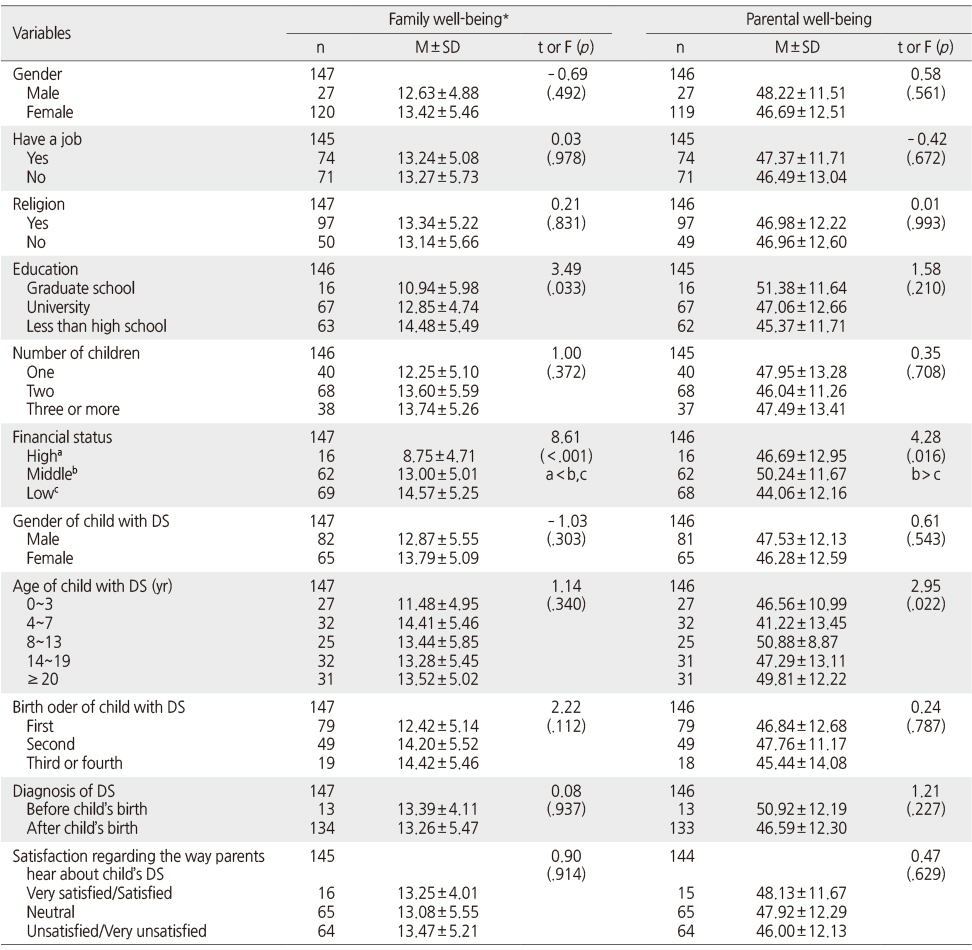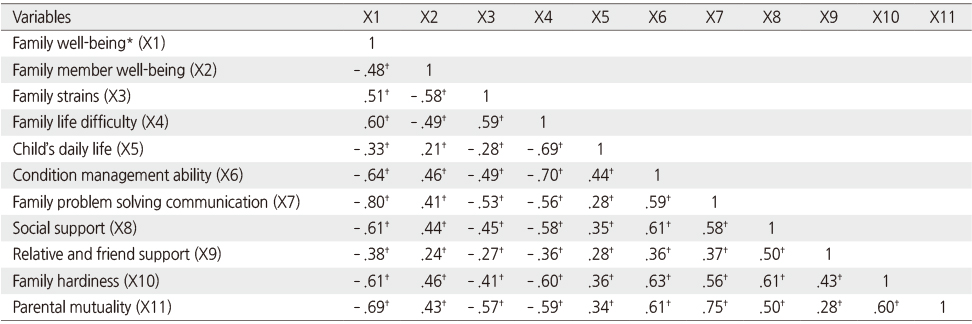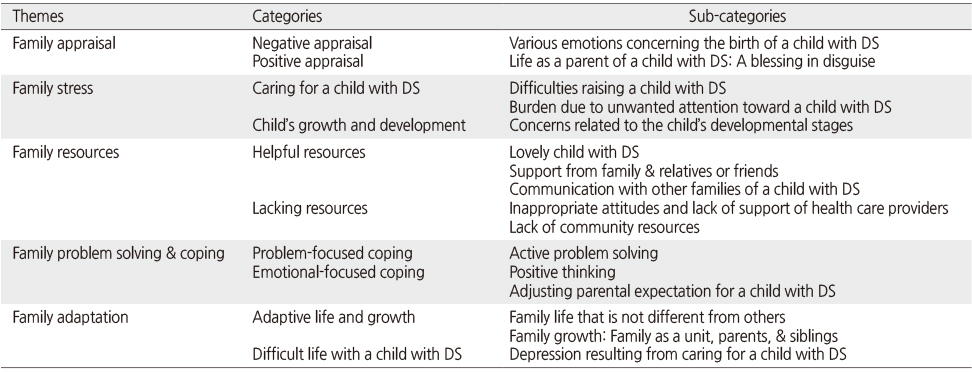Articles
- Page Path
- HOME > J Korean Acad Nurs > Volume 45(4); 2015 > Article
-
Original Article
- Adaptation in Families of Children with Down Syndrome: A Mixed-methods Design
- Hyunkyung Choi
-
Journal of Korean Academy of Nursing 2015;45(4):501-512.
DOI: https://doi.org/10.4040/jkan.2015.45.4.501
Published online: August 31, 2015
College of Nursing · The Research Institute of Nursing Science, Kyungpook National University, Daegu, Korea.
- Address reprint requests to: Choi, Hyunkyung. College of Nursing · The Research Institute of Nursing Science, Kyungpook National University, 680 Gukchabosang-ro, Jung-gu, Daegu 41944, Korea. Tel: +82-53-200-4791, Fax: +82-53-421-2758, hchoi@knu.ac.kr
© 2015 Korean Society of Nursing Science
This is an Open Access article distributed under the terms of the Creative Commons Attribution NoDerivs License. (http://creativecommons.org/licenses/by-nd/4.0/) If the original work is properly cited and retained without any modification or reproduction, it can be used and re-distributed in any format and medium.
Abstract
-
Purpose
- The purpose of this study, which was guided by the Resiliency Model of Family Stress, Adjustment, and Adaptation, was twofold: (a) to explore family and parental adaptation and factors influencing family adaptation in Korean families of children with Down syndrome (DS) through a quantitative methodology and (b) to understand the life with a Korean child with DS through a qualitative method.
-
Methods
- A mixed-methods design was adopted. A total of 147 parents of children with DS completed a package of questionnaires, and 19 parents participated in the in-depth interviews. Quantitative and qualitative data were analyzed using stepwise multiple regression and content analysis respectively.
-
Results
- According to the quantitative data, the overall family adaptation scores indicated average family functioning. Financial status was an important variable in understanding both family and parental adaptation. Family adaptation was best explained by family problem solving and coping communication, condition management ability, and family hardiness. Family strains and family hardiness were the family factors with the most influence on parental adaption. Qualitative data analysis showed that family life with a child with DS encompassed both positive and negative aspects and was expressed with 5 themes, 10 categories, and 16 sub-categories.
-
Conclusion
- Results of this study expand our limited knowledge and understanding concerning families of children with DS in Korea and can be used to develop effective interventions to improve the adaptation of family as a unit as well as parental adaptation.
This research was supported by Basic Science Research Program through the National Research Foundation of Korea (NRF) funded by the Ministry of Education (No. NRF-2013R1A1A1058809).
- 1. National Down Syndrome Society. Down syndrome facts [Internet]. New York, NY, National Down Syndrome Society. 2014;cited 2014 November 2. Available from: http://www.ndss.org/Down-Syndrome/Down-Syndrome-Facts/
- 2. Choi H, Van Riper M. Maternal perceptions of sibling adaptation in Korean families of children with Down syndrome. J Intellect Disabil Res. 2014;58(10):962–977. ArticlePubMedPDF
- 3. Choi EK, Yoo IY. Resilience in families of children with Down syndrome in Korea. Int J Nurs Pract. 2014;Forthcoming.
- 4. Kim MY. Mothers' adjustments in raising children with down syndrome. J Korean Clin Nurs Res. 2008;14(2):19–29.
- 5. Bourke J, Ricciardo B, Bebbington A, Aiberti K, Jacoby P, Dyke P, et al. Physical and mental health in mothers of children with Down syndrome. J Pediatr. 2008;153(3):320–326. ArticlePubMedPMC
- 6. Lam LW, Mackenzie AE. Coping with a child with Down syndrome: The experiences of mothers in Hong Kong. Qual Health Res. 2002;12(2):223–237. ArticlePubMedPDF
- 7. Eisenhower AS, Baker BL, Blacher J. Preschool children with intellectual disability: Syndrome specificity, behaviour problems, and maternal well-being. J Intellect Disabil Res. 2005;49(Pt 9):657–671. ArticlePubMedPMC
- 8. Sari HY, Baser G, Turan JM. Experiences of mothers of children with Down syndrome. Paediatr Nurs. 2006;18(4):29–32. Article
- 9. Wikler L. Chronic stresses of families of mentally retarded children. Fam Relat. 1981;30(2):281–288. Article
- 10. Van Riper M. Families of children with Down syndrome: Responding to "a change in plans" with resilience. J Pediatr Nurs. 2007;22(2):116–128. ArticlePubMed
- 11. Hodapp RM. Families of persons with Down syndrome: New perspectives, findings, and research and service needs. Ment Retard Dev Disabil Res Rev. 2007;13(3):279–287. ArticlePubMed
- 12. McCubbin HI, Thompson AI, McCubbin MA. Family assessment: Resiliency, coping and adaptation: Inventories for research and practice. Madison, WI: University of Wisconsin Publishers; 1996.
- 13. Lee HC, Kim YC, Kim KS. Mixed methods research: Qualitative research and quantitative research. Paju: Academypress; 2013.
- 14. Guillemin F, Bombardier C, Beaton D. Cross-cultural adaptation of health-related quality of life measures: Literature review and proposed guidelines. J Clin Epidemiol. 1993;46(12):1417–1432. ArticlePubMed
- 15. Skinner HA, Steinhauer PD, Santa-Barbara J. FAM-III™ Family assessment measure-III. North Tonawanda, NY: Multi-Health Systems Inc.; 1995.
- 16. Knafl K, Deatrick J, Gallo A, Dixon J, Grey M, Knafl G, et al. Family management measure (FaMM) [Internet]. Chapel Hill, NC, The University of North Carolina at Chapel Hill. 2014;cited 2014 November 2. Available from: http://nursing.unc.edu/research/office-of-research-support-consultation/resources/family-management-measure-famm/
- 17. Graneheim UH, Lundman B. Qualitative content analysis in nursing research: Concepts, procedures and measures to achieve trustworthiness. Nurse Educ Today. 2004;24(2):105–112. ArticlePubMed
- 18. Olsson MB, Hwang CP. Socioeconomic and psychological variables as risk and protective factors for parental well-being in families of children with intellectual disabilities. J Intellect Disabil Res. 2008;52(12):1102–1113. ArticlePubMed
- 19. Povee K, Roberts L, Bourke J, Leonard H. Family functioning in families with a child with Down syndrome: A mixed methods approach. J Intellect Disabil Res. 2012;56(10):961–973. ArticlePubMed
- 20. Trute B, Hiebert-Murphy D, Levine K. Parental appraisal of the family impact of childhood developmental disability: Times of sadness and times of joy. J Intellect Dev Disabil. 2007;32(1):1–9. ArticlePubMed
- 21. Hsiao CY, Van Riper M. Individual and family adaptation in Taiwanese families living with Down syndrome. J Fam Nurs. 2011;17(2):182–201. ArticlePubMedPDF
- 22. Saloviita T, Italinna M, Leinonen E. Explaining the parental stress of fathers and mothers caring for a child with intellectual disability: A double ABCX model. J Intellect Disabil Res. 2003;47(Pt 4-5):300–312.ArticlePubMed
- 23. Sim MK. Influence of resiliency factors on adaptation in families of children with cancer. Korean J Child Health Nurs. 2004;10(4):383–394.
- 24. Clark PC. Effects of individual and family hardiness on caregiver depression and fatigue. Res Nurs Health. 2002;25(1):37–48. ArticlePubMed
- 25. Davis K, Gavidia-Payne S. The impact of child, family, and professional support characteristics on the quality of life in families of young children with disabilities. J Intellect Dev Disabil. 2009;34(2):153–162. ArticlePubMed
- 26. Jeon MS. Customized service for persons with developmental disabilities will be provided. Ministry of Health & Welfare Press Release [Internet]. Seoul, Ministry of Health & Welfare. 2012;07 13 cited 2014 November 2. Available from: http://english.mw.go.kr/front_eng/sg/ssg0111vw.jsp?PAR_MENU_ID=1001&MENU_ID=100111&page=7&CONT_SEQ=274342
REFERENCES
Figure & Data
REFERENCES
Citations

- Perceived stress and family adaptability in head and neck cancer patients receiving radiotherapy: the chain-mediated effect of social support and family resilience
Xiaoru Li, Yu Zhu, Hongwei Wan
Frontiers in Psychiatry.2025;[Epub] CrossRef - Family adaptation in families of individuals with Down syndrome from 12 countries
Marcia Van Riper, George J. Knafl, Kathleen A. Knafl, Maria do Céu Barbieri‐Figueiredo, Sivia Barnoy, Maria Caples, Hyunkyung Choi, Beth Cosgrove, Elysângela Dittz Duarte, Junko Honda, Elena Marta, Supapak Phetrasuwan, Sara Alfieri, Margareth Angelo, Wann
American Journal of Medical Genetics Part C: Seminars in Medical Genetics.2024;[Epub] CrossRef - ADAPTATION OF THE FAMILY HARDINESS INDEX (FHI) INSTRUMENT FOR INDONESIAN ADOLESCENTS
Luisa Erica, Sri Redatin Retno Pudjiati
Jurnal Ilmu Keluarga dan Konsumen.2024; 17(2): 120. CrossRef - Adaptation at the Family Level in Families of Individuals With Down Syndrome: A Scoping Review
Marcia Van Riper, Bethany Cosgrove, Louise Fleming
Journal of Family Nursing.2023; 29(4): 324. CrossRef - Perceptions of families with adolescents utilizing augmentative and alternative communication technology: A qualitative approach
Patricia West, Emily J. Jensen, Sarah N. Douglas, Gwen Wyatt, Lorraine Robbins, Charles Given
Journal of Pediatric Nursing.2023; 71: e46. CrossRef - Factors influencing quality of life in caregivers of adolescents with developmental disabilities
Joung Woo Joung
Osong Public Health and Research Perspectives.2022; 13(4): 298. CrossRef - Perceived Experiences of Korean Immigrant Mothers Raising Children With Disabilities in the United States
Anna Lee, Vicky J.-H. Yeh, Kathleen A. Knafl, Marcia Van Riper
Journal of Transcultural Nursing.2022; 33(2): 219. CrossRef - A Predictive Model of Resilience in Mothers of Children with Developmental Disabilities
Youyoung Cho, Hyeonok Kim
Journal of Korean Academy of Nursing.2022; 52(4): 407. CrossRef - Tracing the Use of the Family Management Framework and Measure: A Scoping Review
Kathleen A. Knafl, Janet A. Deatrick, Agatha M. Gallo, Beth Skelton
Journal of Family Nursing.2021; 27(2): 87. CrossRef - Measurement of Family Management in Families of Individuals With Down Syndrome: A Cross-Cultural Investigation
Marcia Van Riper, George J. Knafl, Maria do Céu Barbieri-Figueiredo, Maria Caples, Hyunkyung Choi, Gert de Graaf, Elysângela Dittz Duarte, Junko Honda, Elena Marta, Supapak Phetrasuwan, Sara Alfieri, Margareth Angelo, Wannee Deoisres, Louise Fleming, Alin
Journal of Family Nursing.2021; 27(1): 8. CrossRef - Down Syndrome, Obstetricians Should Know
Ji-Hee Sung, Soo Hyun Kim, Sir-yeon Hong, Chi-Son Chang, Yejin Kim, Jungeun Jeon, Hyea Park, Soo-young Oh
Perinatology.2021; 32(1): 1. CrossRef - mHealth Family Adaptation Intervention for Families of Young Children with Down Syndrome: A Feasibility Study
Hyunkyung Choi, Marcia Van Riper
Journal of Pediatric Nursing.2020; 50: e69. CrossRef - Adaptation and Resilience in Families of Children With Spina Bifida in South Korea
Eun Kyoung Choi, Marcia Van Riper, Mina Jang, Sang Won Han
Rehabilitation Nursing.2018; 43(6): 343. CrossRef - Raising a Child with Down Syndrome: Do Preferred Coping Strategies Explain Differences in Parental Health?
Tatjana Alexander, Julia Walendzik
Psychology.2016; 07(01): 28. CrossRef
Family and Parental Adaptation according to Demographic Characteristics
*Low values on family well-being indicate better family adaptation; DS=Down syndrome.
Correlations among Family Factors (N=141)
*Low values on family well-being indicate better family adaptation; †Significant at the 0.05 level.
Family Factors Influencing Family and Parental Adaptation
*Low values on family well-being indicate better family adaptation.
Parental Experiences in Families of Children with Down Syndrome
DS=Down syndrome.
*Low values on family well-being indicate better family adaptation; DS=Down syndrome.
*Low values on family well-being indicate better family adaptation; †Significant at the 0.05 level.
*Low values on family well-being indicate better family adaptation.
DS=Down syndrome.
 KSNS
KSNS
 E-SUBMISSION
E-SUBMISSION




 Cite
Cite

